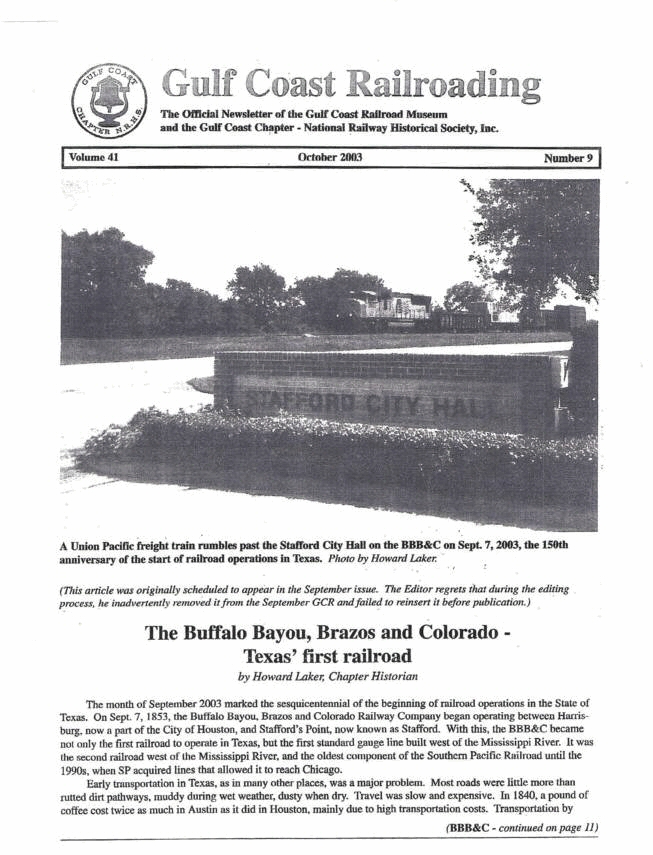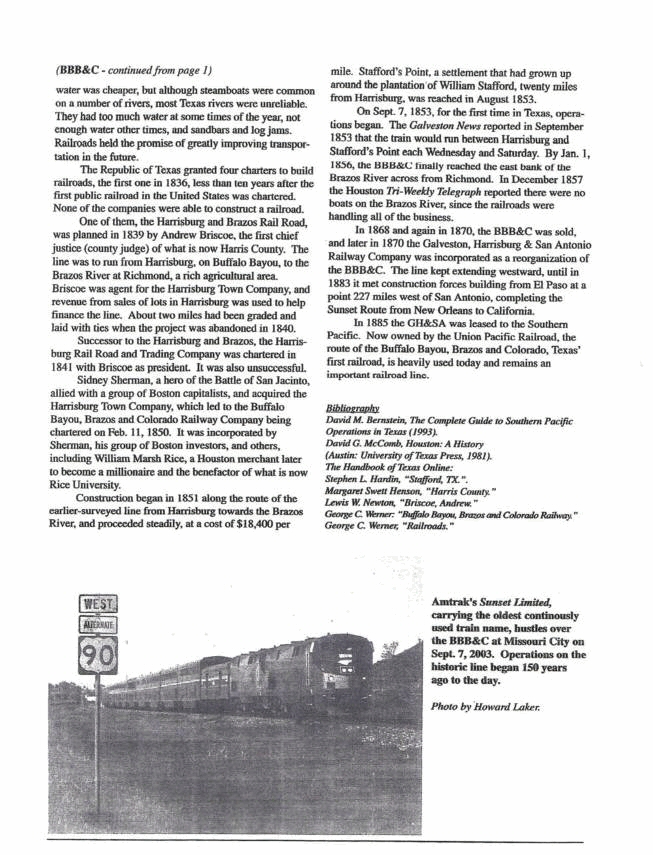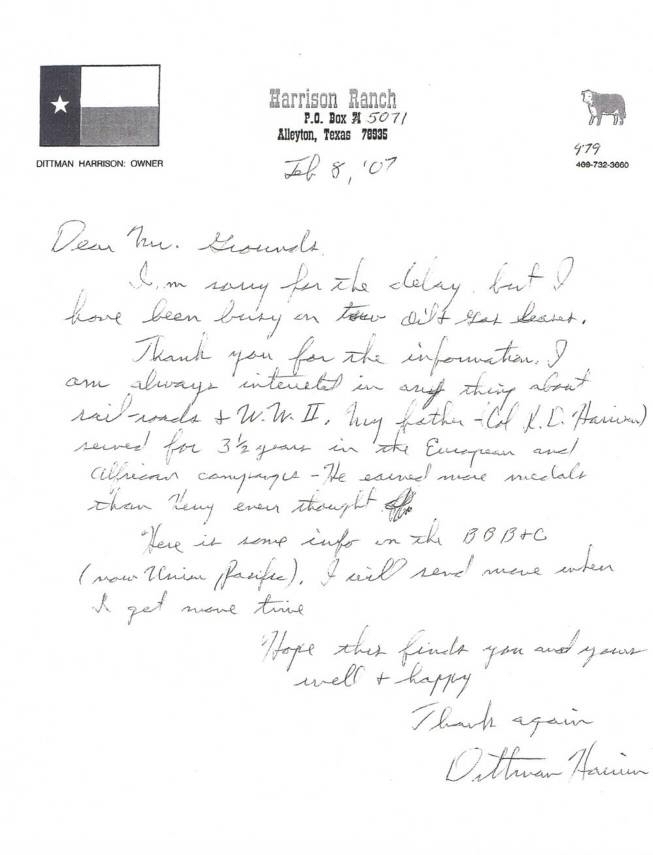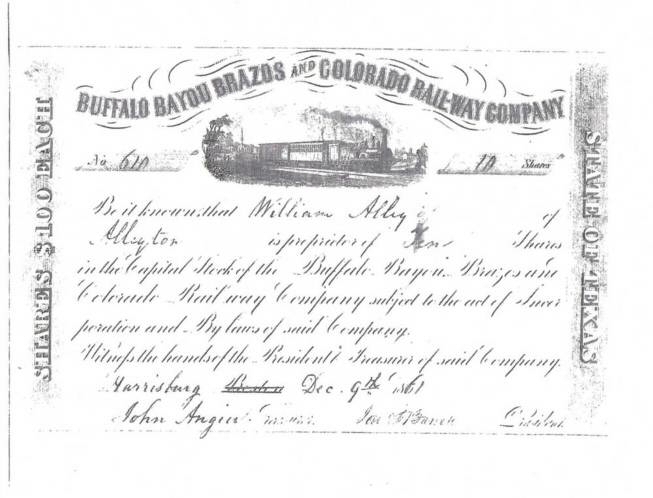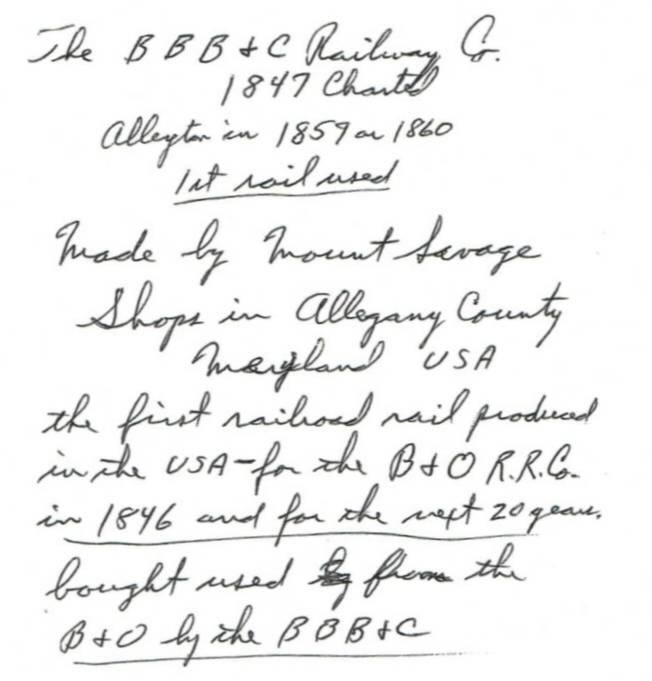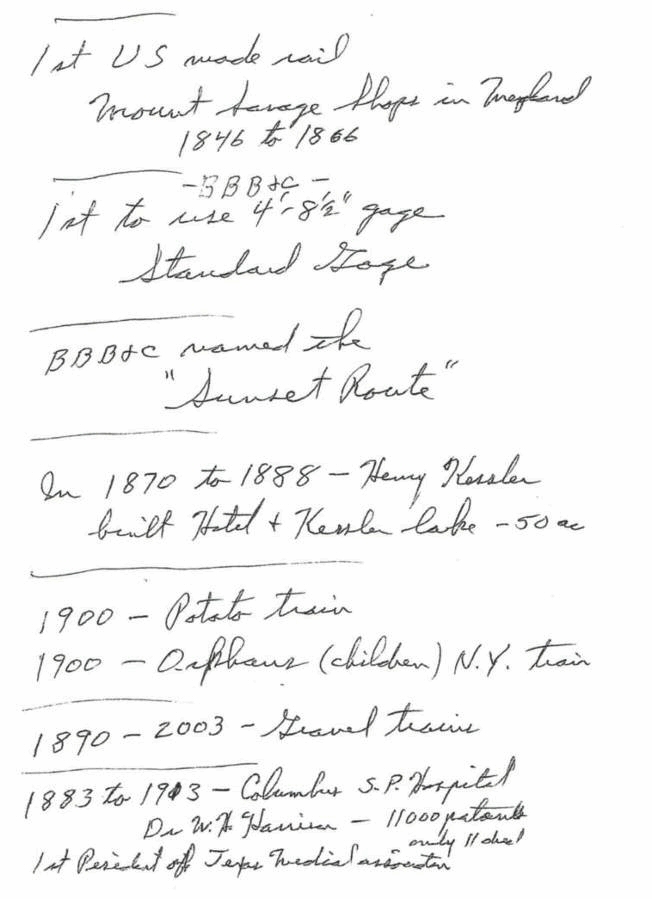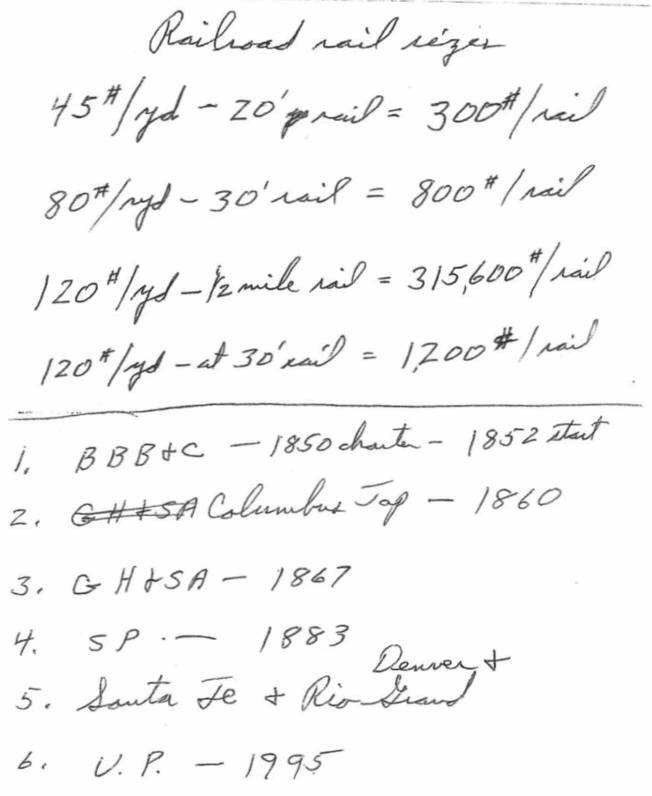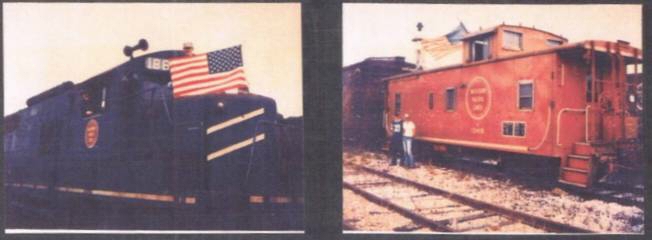

This interview
was taken on July 3, 2007. It is an interview by John Walker of Howard
Grounds. Howard followed his grandfather and his father as a railroad
employee. Howard had the honor of driving the Sugar Land Rail Road on its
last run.
Transcript
WALKER: Iím
interviewing Mr. Grounds today. We are looking at photos and he is
telling me about them and about his years as a railroad engineer. Let me
ask you about the Highway 6 Sugar Land railroad was it a steam locomotive?
GROUNDS:
Yea.
WALKER:
When did they retire that?
GROUNDS:
That happened during World War II.
WALKER:
After World War II, was all diesel?
GROUNDS:
No, no, it wasnít. They run steam way up into the 50ís, í57.
WALKER:
Okay
GROUNDS:
[referring to a photo of his father] This here one was from 1941. Daddy took
this and he was a conductor. It says on the side: No Japanese allowed to ride on your train.
WALKER:
Thatís the way it was in those days. Donít lose the train to the
Japanese.
GROUNDS:
Thatís a Casey Jones look-alike engine. It wasnít his engine, just one
like it though. (sound of pages turning) (chuckling). Hereís my
DaddyÖ little Boy Scout got to ride the train with him. This is round
house bunch, out here. This is the engine out of Galveston on a
turntable, youíve seen that down there at the museum? That use to be down at
Trinity.
WALKER:
Did you ever get to cross the causeway with cars?
GROUNDS:
Did I! For 40 years, I had the job, regular for ten years.
WALKER:
Did they run another train? Older car but the train.
GROUNDS:
It pulled everything it had behind it. This is only a Texas State
railroad here.
WALKER:
Did you ever run across the old Brazos River bridge going to Freeport, remember
the swing bridge in Freeport that cars and trains shared? Then there was
another one that cars and trains shared. Thatís when they crossed Bastrop
down at Hoskinís Mound. [Walker offers this link to what they are
discussing: www.flickr.com/photos/library_of_congress/2179911898/]
GROUNDS:
Well yea, down there at milepost 4, I didnít knowÖ that never turned. I
never did see it turn.
WALKER:
No it never turned, I donít think. The one Iím talking about that went
over Bastrop Bayou, you know where both car road and train tracks came together
to share one bridge over Bastrop Bayou. Do you remember the rails after
the hurricane Carla hit them?
GROUNDS:
Yea, it was known as the junk pile after that.
WALKER:
Down at Hoskins Mound. When they put up the railroad bed, to keep it from
becoming a levy, they engineered a trestle every half a mile or so to allow the
water to flow underneath it. During hurricane Carla where ever the water
went underneath the tracks all the logs from the beach stopped against the
rails at each trestles and the waves of the storm pushed on the logs that bent
the rails down... Bent the rails together still nailed to the cross ties.
GROUNDS:
How about that, this is the old feed mill. [Referring to a photo] Do you
remember the old feed mill that used to be out there?
WALKER:
Yea and the best I can tell right now itís where the Firestone Tire place
is.
GROUNDS:
Um-hum. (Sound of pages turning). This is my last day on the
railroad; I took my grandkids, my daughter. Let her run the engine.
She said, ďDaddy youíre libel to get fired.Ē I said, ďLet them fire me, I
donít care.Ē
WALKER:
(laughing) So this Allen Johnson is heÖ
GROUNDS:
Thatís my Motherís first cousin. Did you ever know him?
WALKER:
No but the Johnsonís are at Trammels.
GROUNDS:
Now this is our little boudon girl, sheís a Johnson. They are Fraddie
Parsonís twins and she was a daughter of one of the twins.
WALKER:
Did you everÖ do you know where Walker Depot was?
GROUNDS:
There at Trammel was a little depot for freight, you know they used to
come off at Rosharon and go around to the top cattle ranch out there, then go
on down to Anchor and they had a depot there. Then you go straight to the
river.
[Note from
Walker: The Sugar Land Railroad ended at Anchor. To continue to Velasco, you
had to change trains. The Columbia Tap RR, The Houston Tap RR and the I &
GN RR all used the original right of way and went from Houston to East Columbia
on the Brazos River. There was probably a Y in rails to allow the trains to
turn around at Anchor. There was a depot on Oyster Creek near Anchor on the I
& GN line. All these lines were purchased by Missouri Pacific eventually.
Follow the link for details of the SLRR
http://lifeonthebrazosriver.com/Sugar%20Land%20Railroad.pdf]
GROUNDS:
Is that old building still there? That old depot?
WALKER:
No itís not, the dump [RR beds are called dump] is there but you can tell where
it went? The Sugar Land railroad that ran [west from Sugar Land] towards the
river went to Hickey. Did you run that far?
GROUNDS:
No, Sugar Land is as far as I ever went.
WALKER:
Sugar Land is where you started and then you went south, right. Then you
went to the feed mill and after the feed mill, where did you go? Did you
go by Johnson store?
GROUNDS:
Yea we come byÖ we come by Trammel, we called it Trammel and then go down
through thru the Scanlan Plantation. And up to the old highway [FM 521 at Hawdon
and north to Holmes Rd in Houston] out there you know.
WALKER:
Youíre talking the old highway, the other road that went across Miller
Road? There wasnít a line to another road? Thatís kind of what I
figured theyíd pulled that upÖ
GROUNDS:
You see those old tracks have been taken up years ago because they use to run
practice trains down here you know.
WALKER:
Houston built the terminal in Sugar Land and they took the railroad
there.
GROUNDS:
Right after World War II or during World War II they had this flood down there
in Freeport and Velasco you know and they had to run freight trains out of
there to get the people out. Did you know that? In fact a lot of
diesels couldnít make itÖ diesels was much more in existence then anyway except
for switching it. They brought those people out of Freeport and Velasco
in boxcars.
WALKER:
There was a flood in 1913 that was a big flood.
GROUNDS:
Yea that was a big one. It had a little island out there. The tracks went
out there into the water to load a ship where the water is deep. Theyíd
wash away. I forget what they call that. They had a name for it.
When it washed away they never put it back.
WALKER:
Was it a camp or did they call it a town or what?
GROUNDS:
Yea, some kind of point they called it.
WALKER: On the
Freeport side?
GROUNDS:
Yea, it wasnít Freeport though. It was down below Freeport, a little further
down I think. I never did see it, I just heard about it.
[Note from Walker: He may be talking about INDIANOLA, TX - Texas State
Historical Association www.tshaonline.org/handbook/.../hvi1]
WALKER:
Okay. There is Quintana
GROUNDS:
I made lots of trips down there to the Hoskins Mound to weigh those sulfur
cars. We had a Hoskins junction and it go on to Angleton and the other
track would go downÖ we use to run those practice trains out through Hoskins
Mound [was a
sulfur dome where the sulfur was melted with hot salt water, pumped to the
surface, and allowed to cool, forming a city block size of pure sulfur]
to take them workers to the sulfur plant. One old engineer, he was an
extra man; he didnít know where the holes was. The regular engineers they
could make the time pretty good, theyíd get to where the holes was theyíd slow
the train down with the breaksÖ it rolled pretty good and then the next hit
again so. Theyíd run on schedule, where the extra engineer come down and
my twin brother was with him and it was hard to make the schedule because of
those holes. This fellow didnít know where the holes was and he made the
schedule. Then people on that train said, ďIf that man runs this train
tomorrow we ainít going because we are NOT driving with him.Ē Even at a
slow rate when he hit them holes you could see them old coaches doing
this. [mimics rocking/jerky motion]
WALKER:
Swaying back and forth.
GROUNDS:
(laughing) and on that mile post four where that first bridge is coming out of
Freeport going out toward the Mound, there was an old engineer. He and
Dad were both engineers and he had a reputation for making the time. So I
was just kidding, it was just pouring down rain, you couldnít see the front
engine from the back, it was really raining. I said, ďYouíre going to
make the time today arenít you?Ē He didnít say nothing, he pulled that
throttle back and I guarantee you we made the time. We got on that
milepost 4 where that first bridge is in an old steam engine and the wheels
started slipping on that bridge. I thought we was on the ground, it
scared me half to death, I thought we was gone. That old engine really
went to dancing when them wheels start slipping on the bridge.
WALKER:
Yea, all they can do is stop and start again.
GROUNDS:
Oh yea, they catch on... theyíd drop a little sand and theyíd catch up with
you. Anyway I wasnít expecting that, it really took me for a
thrill. I got the fellas stuff, just sit tight and Iíll find it.
WALKER:
How many railroads did you work on?
GROUNDS:
About five or six. I started out on the Zurk Pacific [Walker: Not sure
this is the the correct spelling.]
WALKER:
Where did it run?
GROUNDS:
Well it run to St. Louis. Itíd go up to Huntsville and Trinity and Palestine
then it run over towards Taylor up that way, Riley Junction and then theyíd run
north to Longview and then up towards St. Louis. I worked on from Zurk
City, from Zurk City it was tied on to Houston terminal so I worked on the Belt
too. The new BeltÖ
WALKER:
Where did it go, from Houston toÖ
GROUNDS:
The Belt didnít go nowhere it stayed in the yardÖ terminal. Then I got
cut off and I went to work on the Southern Pacific and
I made some trips down to the Brazos River to a placed called Echo and changed
crews there. Then I worked on the Houston Port and Terminal, I didnít get
a paycheck from them but I did get over on their property and switch carsÖ
called them transfers. Down here around country drive and down through
that way is a lot of waterfront. I worked with them and letís see what
else did I do? The Union Pacific come along and bought the Zurk Pacific,
I worked on five or six different railroads and I am what you call a
boomer. You ever worked on a motorman railroad and youíre a boomer. I was
a deluxe boomer I guess.
WALKER:
(laughing)
GROUNDS:
The best railroad I ever worked for was the Union Pacific, they treated
employees nice, they really did.
WALKER:
Where did you run on the Union Pacific?
GROUNDS:
I had 650 miles of each, Iíd could go to Longview, I could go to Taylor and I
could run to Galveston, Freeport, Sugar Land all them varieties.
WALKER:
But you still ran in Texas?
GROUNDS:
Yea, I stayed in Texas.
WALKER:
What about the DeWalt Barn? Do you remember that?
GROUNDS:
I remember it had a store at DeWalt.
WALKER:
Remember, what they stored cotton in? The FHA boys stored their cotton
and hayÖ it was built for cotton but it ended up for hay.
GROUNDS:
Most of that cotton business was all gone before I ever got over down there.
WALKER:
Did you ever see Sugar Cane growing? In the Ď40s was when they quit
running sugar cane.
GROUNDS:
You see in the 1940ís I wasnít working on the railroad. I didnít start
until í46. I think this is what I was trying to find for you. This
fella has got a ranch; his ranch is on a Spanish land grant. It wasnít
granted to him. Now Laura Bushhall, that bunch, their property was
Spanish land grant. This is the fellow ranching out there now. You
might read this and maybe make some copies because he tells about the railroads
(sound of photos being shuffled) Iíll make you a copy and you get hold of him
heís a railroad buff.
WALKER:
Oh is he, okay.
GROUNDS:
Heís out there in that area, Columbus.
WALKER: Down
where Alex is?
GROUNDS:
Okay, he shows address somewhere other thanÖ I met him in Columbus and then at
one of those Rotary meeting things. Heís involved in Rotary.
WALKER:
This is probably his telephone number?
GROUNDS:
Yea, evidently. You tell him Iím the fella that met him down there at the
cafeteria down there in Columbus and he was putting the flags away he had for
the Kiwanis Club. Right now I imagine heís busy getting his cattle out of
the water.
WALKER:
Yea, the Colorado River would be up over there.
GROUNDS:
[looking at photo] See my three-corner hat I was wearing? My daughter
made that freedom run up there to Washington and seen all that early stuff, so
she brought me back this three-corner hat and I wore it. (Paper shuffle)
This is taken in Galveston, but I come through League City there. They
had built this Gazebo by the railroad tracks and they had man there and I come
up there. They didnít know I was coming with a big flag on the
engine. I didnít know they was going to have a ceremony out there on that
Gazebo. Them people seen that big flag and they went crazy! All of
them pitched their hats up in the air. It was something. They took
some pictures of the engine. Some of them got in the car and they took
pictures ahead of the train with them big flags flying. The only pictures
I could get of the thing was after I got to Galveston. I got off the
engine and I had this friend of mine who took the photo. I want you to
have a copy.
WALKER:
Did you ever know Hal Vilman in Stafford?
GROUNDS:
I didnít know him anybody but kin folks out here. Uncle Frank has a
little store out here. Do you remember that old store? It stayed
there for many years. I guess it done rotted down. He had a little
gas pump.
WALKER:
In Stafford?
GROUNDS:
No, in Rosharon, no Trammel.
WALKER:
Johnson store is still standing.
GROUNDS:
I bet itís in pretty bad shape isnít it?
WALKER:
Yea, but I just went by with Joe Fenn the week before last and itís still
standing.
GROUNDS: Itís
not supposed to beÖ they are not using it, no way.
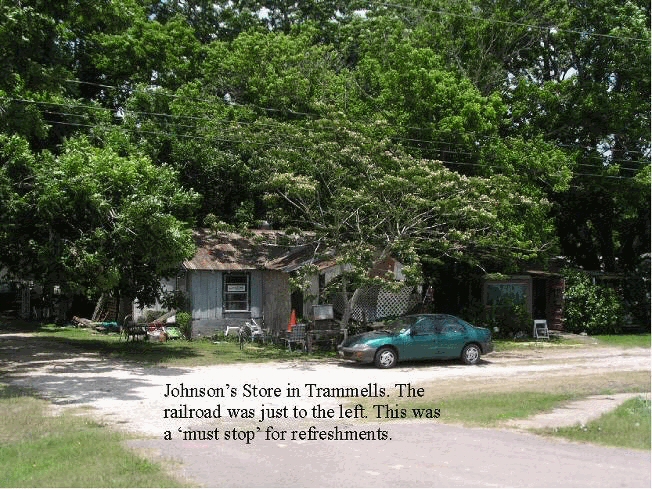
GROUNDS:
Anyway, when I was a kid he had one gas pump. Thatís his granddaughter,
she married somebody named Bodice. She was daughter of one of the twin
boys, Brady Parce.
GROUNDS:
Thatís July Fourth 1976, had to have special permission to put that flag on the
engine. These are some of the original pictures.
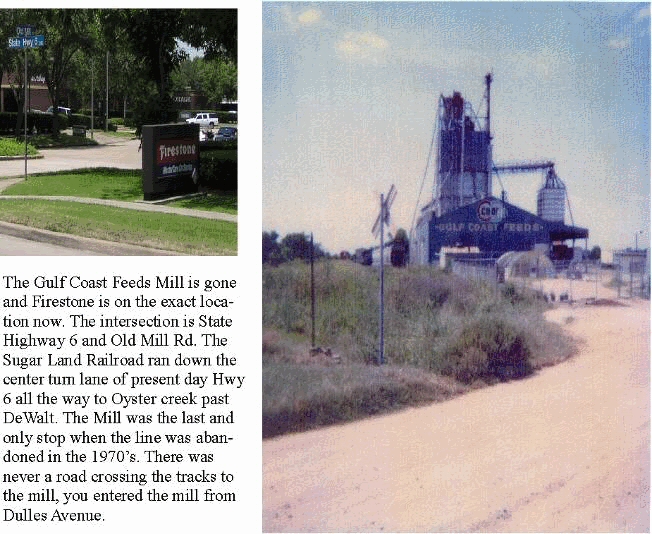
GROUNDS:
This is right here at Trammell, where Uncle Frankís store used to be.
This is the last crew that worked in Sugar Land.
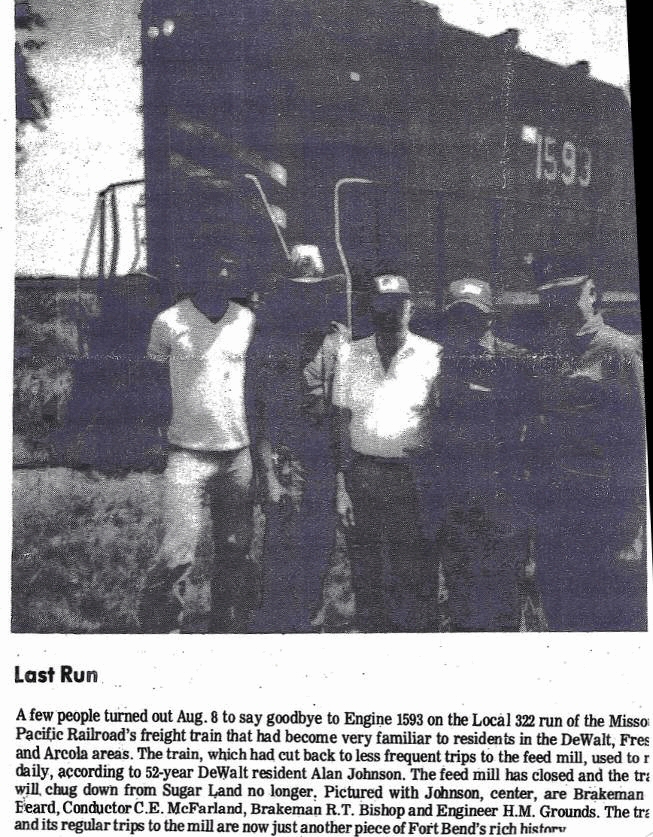
WALKER: I
never did know him.
GROUNDS:
You heard of him, havenít you?
WALKER:
Yea, because I know the JohnsonísÖ you know the Fosters? Barbara was a Johnson
before she married Gene Foster. They ran the Viking Den in Stafford.
GROUNDS:
You might want to take this photo. This is telling Sugar Land
goodbye. My last trip to Sugar Land.
WALKER:
Do you have any pictures of the DeWalt store something like that?
GROUNDS:
I didnít know Frankís old store was still standing. I was out in
California and I took this picture. Santa Fe come out and I snapped
it. By the time got my finger off it was gone. Good gosh I missed
him, well I didnít miss him, I caught him. This is my Daddies last trip
before he retired. This one here is the same day. He was running an
EagleÖ this is a sunshine special. Thatís old, old time passenger
train. This is taken on the same day. Of course they donít mean a
thing.
WALKER: With
snow on the ground. (chuckle)
GROUNDS:
Yea, it looks like it a little snow there. This is my Daddiesí old
crew. Thatís his porter and his engineer and his break man and this is
his fireman. Down at the Union Station.
WALKER: I
am looking at those pictures of steam engines.
GROUNDS:
Youíre interested in steam engine pictures? Iíll show you some good
ones. This is a modern shop that I use to work out the city.
This is my twin brother and I together.
WALKER:
You both workedÖ
GROUNDS:
Both 18 years. They use to call him, Wetgrass, they called me
Drygrass. Heís a pretty good drinking man. Hereís the Belt
Terminal, this building the Galaxy lived in. This is my daddyís last
trip, 1957. This is the one when Iím making my last trip.
WALKER:
You havenít got a chance to read that book of Mona Fennís Glimpses of Our
History?
GROUNDS:
I am going to. Right, Iím glad you done that. She is a nice little
gal isnít she?
WALKER:
Isnít she!
GROUNDS:
She is just full of joy. It tickled me, she said, ďHoward you know your
responsible for all this.Ē This diesel of ours, passenger train, hit this
truck out here on Westfield and the Engineer and Fireman were both
killed. The Engineer jumped off, got a stick through his head and the Fireman
run back to the second unit and sucked all that fire and burned him up.
Had both stayed on the engine they would have survived. They had a flash fire
in the engine all that sucked out aboard the engine. They would have
survived had they stayed on the engine.
WALKER:
Where is this?
GROUNDS:
Down at Westfield going out toward Palestine, toward Conroe.
WALKER:
And it hit something.
GROUNDS:
A butane truck, ah-ha.
WALKER:
Oh boy. A butane truck.
GROUNDS: Ah-ha. (Rustling paper) Here is that
old Texas Eagle. They had got away with this thing. Look right
there coming out on 59. We use to go underneath it.
WALKER: I think itís still there.
GROUNDS:
I think this part is gone.
WALKER:
Oh is it, because they put that overpass on it. I thought they were
building right around it but I donít know if it works.
GROUNDS:
This is a picture of the old General, a Civil War thing. Thatís a
lookalike picture itís not the engine. Okay this is out at the Galveston
Railroad Museum. I volunteered out there 15 years ago in Operation
Lifesaver. Trying to keep kids off the railroad track and getting killed,
hurt I tell you. Thatís the old Bessie Jones, its lookalike engine. They
never did rebuild this engine.
WALKER:
You got the book that tells the story?
GROUNDS:
No, I donít think I do. You know people really talked about what
happened. We had all kinds of warnings and he hit the torpedoes, he
passed the Flagman, never touched the break. Thatís what they was out
there for. To let him know he had problems. He ignored it, heís the one
that got them fellas full of piss and vinegar. He was a depot man, he
thought initially it wasnít his job. He was going to show themÖ he was
running late and he was going to make the time up. So he told his Fireman
jump, he was a black fireman and he did jump. (Papers rustling)
Thatís oneÖ thing we had out in Galveston. This is where I start out on
the UP.
WALKER:
So whatís different now than then?
GROUNDS:
All the thingsÖeverything is so different for some reason.
WALKER:
Right, you use to be able to change your own switch right?
GROUNDS:
Well they still do a lot of that especially on switching areas. I was telling
you about this Virginia Company, used to be a few years back. Big Boy
they called it.
WALKER:
You used to cross the Frost Ranch? Thatís where you went, thatís where
the Mill was. You had to cross the Frost Ranch to get there?
GROUNDS:
Ah-hum, these bulkheads have grown. Thatís how long Iíve been
retired. My conductor bought me a bar-b-q dinner for that last
trip. (Rustling paper) Oh hereís my daughter running the engine.
WALKER:
(giggle)
GROUNDS:
These are some of the people I worked with.
WALKER:
You know a steam engine is noisy.
GROUNDS:
Oh yea, hot to.
WALKER:
Yea
GROUNDS:
This is some postcard pictures of some pretty engines.
WALKER:
Yea
GROUNDS:
This is not the right one but Iíve got another book. I have a bunch of
engines there.
WALKER:
So you didnít know too many people from Sugar Land?
GROUNDS:
I just knew my family, I just knew my family out there. Uncle Frank and
his wife Helen and their daughters and their two sons. Thatís Jessie
Jones old home. They moved up there to Jackson Tennessee.
WALKER:
Were you just interested in a straight Casey Jones or you kin to it or what?
GROUNDS:
No, just a little bit of knowledge. There is something here, same
operation, lifesaver. You ever take that ride up at Palestine that runsÖ
WALKER:
No
GROUNDS:
Thatís interesting they are trying to close it. Thatís some of their
engines.
WALKER:
Thatís still a steam engine, isnít it?
GROUNDS:
Yea, oh yea. Itís all steam they donít run nothing but steam that I
know of.
WALKER:
You canít get the fun part right on the engine. You canít get where all the
noise is at.
GROUNDS:
Come on in, Iíll show you something. (going to another room)
WALKER:
(laughing)
GROUNDS:
This is my daddies KKK card. In 1900, 1915, something like that had this revolt
out here, where these blacks, the ones doing all the planning, they actually
started a shooting war over there. And every red blooded white man in
Houston joined the KKK. I told my daddy, I said, ďDaddy why donít you
tell me about it?Ē He said, ďI wasnít very proud of it.Ē
WALKER:
Yea, Things were different. Is this a railroad watch?
GROUNDS:
Well thatís an emblem. Iíve got four or five railroad watches. In
fact I use to keep an old delay itís got a little choo-choo on the back.
This will run, itís a Westclock, most people look at it and thinkÖ
WALKER:
Well they wouldnít know the difference.
GROUNDS:
I got Daddiesí lines. These are mostly railroad belt buckles most of
them.
WALKER:
Son of a gun.
GROUNDS:
When I retired they gave me this.
WALKER:
Were you and your twin brother in the navy?
GROUNDS:
Yea, world War II. Thatís one of the ships I served on. I served on
three Navy cruisers.
WALKER:
Where were you stationed at, just at sea?
GROUNDS:
Went to San Diego, Blue Cap we stayed in the South Pacific all the way. From
Wake Island to Tokyo Bay. Thirteen major invasions and we was in Japan
when theyÖ thereís a boot camp picture.
WALKER:
Golly
GROUNDS:
This is a 1940 adding machine Iíve got. Iíve also got a 1940 LG Spur,
itís a typewriter. LG Smith Corona
WALKER:
You could tell it would only go to a thousand dollars.
GROUNDS:
I didnít know. It will add up though.
WALKER: I
mean the maximumÖ you got the cents and then you got only 900 dollars and
thatís it. If you had $1,000 dollars you were over capacity of the
machine.
GROUNDS:
(chuckle)
Interview ends.
[Notes provided by John
Walker:
The original SLRR went from
Sugar Land to Duke, Texas under the direction of Colonel Cunningham. It was
funded in 1893 and completed in 1894 or 1895.
Mr. Eldridge took over
about 1896 and the line was completed from Sienna Plantation and McKeever Rd
through Sugar Land Junction [the intersection of the Santa Fe RR and Sugar Land
RR was called Sugar Land Junction] to Otey and to Anchor. At Anchor the line
made connections to the Velasco RR and the International and Great Northern
RR.
By 1912 the line from McKeever
Rd. [presently named Sienna Parkway] and Duke, Texas has been abandoned.
By 1908 there was a spur of
the International and Great Northern at Hawdon to the Arcola Sugar Mills
[House, Texas].
The International and Great
Northern became the Houston Belt and Terminal and then Missouri Pacific.
When Missouri Pacific purchased
the Sugar Land RR in 1956 I don't think it went any further than Arcola Sugar
Mills. Howard Grounds claimed he never drove a train south of Arcola
Sugar Mills. This location is not to be confused with Arcola's location today.
By this time Missouri Pacific had already purchased the International and Great
Northern's spur from Arcola Sugar Mills to Hawdon. Today this spur is referred
to as part of the Sugar Land RR but it never was part of the original Sugar
Land RR.
In the 1960's and 1970's
the engineer Howard Grounds would drive the train from Sugar Land to the Arcola
Sugar Mills [House, Texas] to Hawdon and into Houston on the tracks beside Texas 288 [presently named FM
521]. Most of these tracks are there today. He would return the same day.
By 1970 people would say
the Sugar Land RR ran to Houston, when really it was no longer the Sugar Land
RR.
This makes it confusing
when someone mentions the Sugar Land RR route.
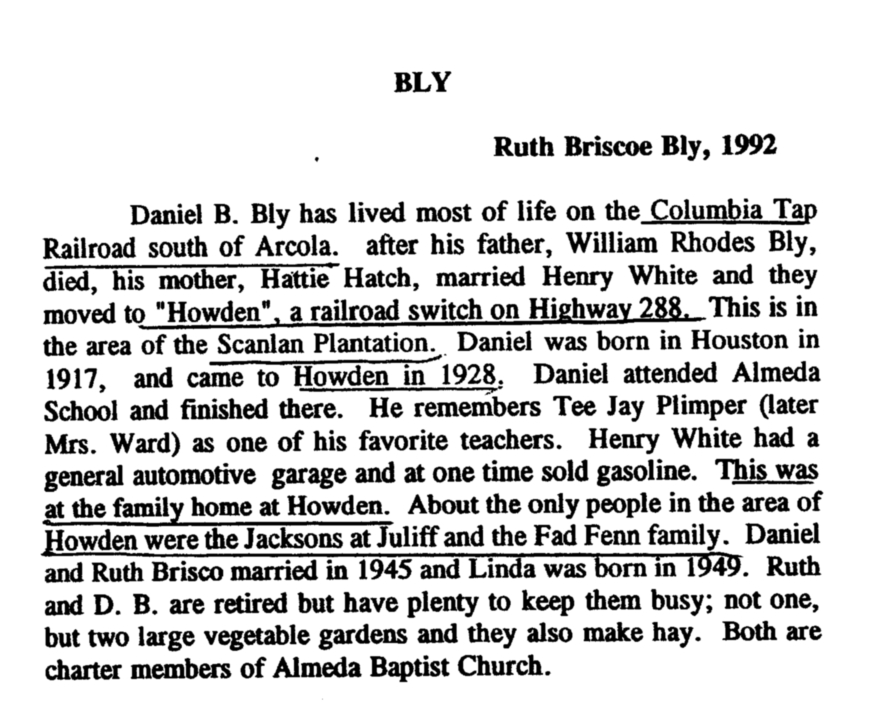
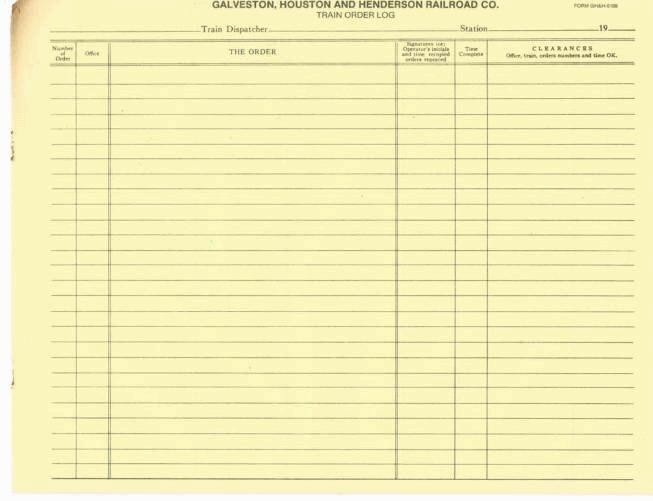
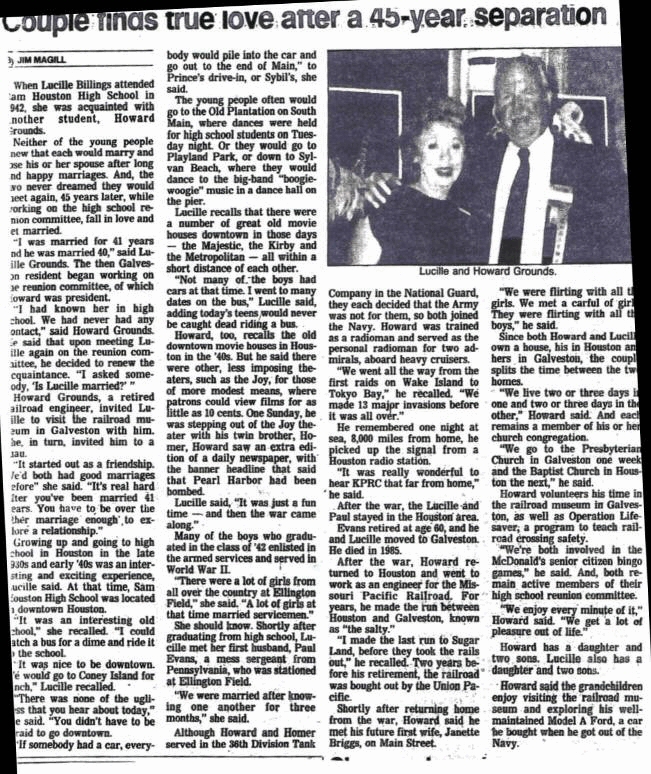
The following items were provided by Howard Grounds about Texas
first railroad.
